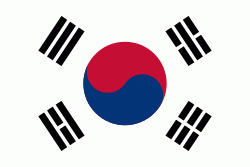Geumjeong District (Geumjeong-gu)
Geumjeong District is a district in north central Busan, South Korea. Approximately 7.3% of Busan's population is in Geumjeong-gu. The Hoedong Reservoir is located on the district's eastern boundary, and the mountain Geumjeongsan on the west. Because of this, 75% of the district's land is restricted from residential development. The district's population is concentrated in the valley of the Oncheoncheon stream, a tributary of the Suyeonggang.
Notable landmarks include Beomeosa, a Buddhist temple dating to the Silla dynasty, and Geumjeongsan, the mountain which overlooks much of the district. Geumjeongsan is topped by the walls of the Geumjeongsanseong, which were built in the Joseon Dynasty.
Several colleges and universities are located in Geumjeong-gu. The most prominent of these is Pusan National University.
Geumjeong-gu serves as a nexus of transit connections between central Busan and the rest of Korea. The northern end of Busan Subway Line 1 lies in Nopo-dong, where it adjoins Busan's major express bus terminal. In addition, the southern terminus of the Gyeongbu Expressway lies within the district.
For most of its history, Geumjeong was officially part of Dongnae, which was itself an independent region until it was amalgamated into the city of Busan in 1942. Geumjeong-gu was formed by separation from Dongnae in 1988.
Originally Geumjeong consisted of 20 administrative dong, but several changes have been made to leave the current total at 17:
* 1992
* Bugok-4-dong was created from Bugok-1-dong
* 1998
* Oryun-dong was absorbed by Bugok-3-dong
Notable landmarks include Beomeosa, a Buddhist temple dating to the Silla dynasty, and Geumjeongsan, the mountain which overlooks much of the district. Geumjeongsan is topped by the walls of the Geumjeongsanseong, which were built in the Joseon Dynasty.
Several colleges and universities are located in Geumjeong-gu. The most prominent of these is Pusan National University.
Geumjeong-gu serves as a nexus of transit connections between central Busan and the rest of Korea. The northern end of Busan Subway Line 1 lies in Nopo-dong, where it adjoins Busan's major express bus terminal. In addition, the southern terminus of the Gyeongbu Expressway lies within the district.
For most of its history, Geumjeong was officially part of Dongnae, which was itself an independent region until it was amalgamated into the city of Busan in 1942. Geumjeong-gu was formed by separation from Dongnae in 1988.
Originally Geumjeong consisted of 20 administrative dong, but several changes have been made to leave the current total at 17:
* 1992
* Bugok-4-dong was created from Bugok-1-dong
* 1998
* Oryun-dong was absorbed by Bugok-3-dong
Map - Geumjeong District (Geumjeong-gu)
Map
Country - South_Korea
 |
 |
| Flag of South Korea | |
The Korean Peninsula was inhabited as early as the Lower Paleolithic period. Its first kingdom was noted in Chinese records in the early 7th century BCE. Following the unification of the Three Kingdoms of Korea into Silla and Balhae in the late 7th century, Korea was ruled by the Goryeo dynasty (918–1392) and the Joseon dynasty (1392–1897). The succeeding Korean Empire (1897–1910) was annexed in 1910 into the Empire of Japan. Japanese rule ended following Japan's surrender in World War II, after which Korea was divided into two zones; a northern zone occupied by the Soviet Union and a southern zone occupied by the United States. After negotiations on reunification failed, the southern zone became the Republic of Korea in August 1948 while the northern zone became the communist Democratic People's Republic of Korea the following month.
Currency / Language
| ISO | Currency | Symbol | Significant figures |
|---|---|---|---|
| KRW | South Korean won | â‚© | 0 |
| ISO | Language |
|---|---|
| EN | English language |
| KO | Korean language |















